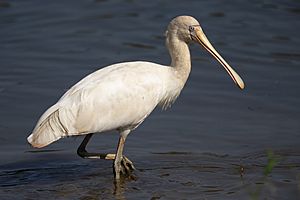Yellow-billed spoonbill facts for kids
Quick facts for kids Yellow-billed spoonbill |
|
|---|---|
 |
|
| Conservation status | |
| Scientific classification | |
| Synonyms | |
|
Platibis flavipes |
The yellow-billed spoonbill (Platalea flavipes) is a unique wading bird. It belongs to the same family as ibises and other spoonbills, called Threskiornithidae. This bird lives mainly in Australia. Sometimes, it flies to places like New Zealand, Lord Howe Island, and Norfolk Island.
Contents
Understanding the Yellow-billed Spoonbill's Name
Scientists give every living thing a special two-part name. This helps everyone around the world know exactly which animal or plant they are talking about. The yellow-billed spoonbill was first described by a famous bird expert named John Gould in 1838. He gave it the scientific name Platalea flavipes.
Later, another scientist, Charles Lucien Bonaparte, thought this bird was so special it needed its own group, called Platibis. John Gould agreed with this idea later on.
Family Tree of Spoonbills
In 2010, scientists studied the DNA of spoonbills. They found that the yellow-billed spoonbill is very closely related to the roseate spoonbill. These two birds are like cousins to the other four spoonbill species. Even though they are a bit different, scientists decided to keep all six spoonbill species in the same main group, Platalea, because they look and act quite similarly.
What Does the Yellow-billed Spoonbill Look Like?
The yellow-billed spoonbill is a medium-sized bird, growing to about 90 cm (35 in) tall. It has beautiful all-white feathers. Its long, flat, spoon-shaped bill is bright yellow. Its face, legs, and feet are also yellow. The bird's eyes are a pale yellow color.
Both male and female spoonbills look very much alike. When it's breeding season, their faces get black lines. They also grow long, fancy feathers on their chests, and the tips of their wings become black.
How Its Bill Works
The yellow-billed spoonbill's bill is narrower than some other spoonbills, like the royal spoonbill. It works more like a pair of tweezers, grabbing small things. The royal spoonbill's bill is wider and acts more like tongs. Like all birds in its family, the yellow-billed spoonbill always flies with its head stretched out straight.
Where Yellow-billed Spoonbills Live
You can find the yellow-billed spoonbill across eastern, northern, and southwestern Australia. They especially like areas near water. They have also been seen sometimes in New Zealand, Lord Howe Island, and Norfolk Island. However, they do not live in Tasmania.
These birds build their nests in trees, marshes, or areas with tall reeds. They often rest in trees. They prefer shallow parts of wetlands, like swamps and lakes. Sometimes, you might even see them in wet fields after heavy rain.
How Yellow-billed Spoonbills Find Food

The yellow-billed spoonbill is a carnivore, meaning it eats meat. It catches small animals by sweeping its unique bill through shallow water. Once it feels something, it quickly snaps its bill shut and swallows its prey.
When it's looking for food, the spoonbill walks slowly. It holds its bill open a little, about 2 to 4 cm (0.8 to 1.6 in), and sweeps it from side to side in a wide arc. As it walks, its feet stir up the bottom of the water. This makes small animals move, which the spoonbill can then sense and catch. If it finds something, it will sweep that small area more carefully to catch all the prey.
Special Sensors on Their Bill
The yellow-billed spoonbill has tiny, blunt bumps called papillae along the edges of its bill. These are like special sensors. They help the bird feel vibrations in the water, which tells it where its prey is hiding.
Studies have shown that these birds usually feed in water less than 40 cm (16 in) deep. They hunt both during the day and at night. Besides sweeping for food, they also poke their bills into underwater plants to find prey. Sometimes, they even catch spiders above the water.
What They Eat
At a place called Lake Cowal in New South Wales, scientists recorded what yellow-billed spoonbills eat. Their diet includes:
- Freshwater crustaceans like the common yabby and shrimp.
- Insects, especially aquatic bugs.
- Small fish, such as mosquitofish and flathead gudgeon.
- Occasionally, they might eat freshwater snails or even some plant material.
Reproduction and Life Cycle
The yellow-billed spoonbill usually nests once or twice a year. They tend to breed when there is plenty of water available. The breeding season changes depending on where they live. In the northern parts of Australia, it's usually from March to May, after the wet season. In cooler areas, it's during winter and spring, from August to October.
The nest is built like a platform made of sticks. It has a hollow center. They often build nests on tree branches or in the fork of a tree, especially if the tree's base is in water. They also build nests in reed beds.
A female spoonbill usually lays two to four dull white eggs. Each egg is about 68 mm (2.7 in) long and 45 mm (1.8 in) wide. Yellow-billed spoonbills often nest together in groups, called colonies. They might share their nesting areas with other birds like royal spoonbills, ibises, herons, egrets, or cormorants.
See also
 In Spanish: Espátula de pico amarillo para niños
In Spanish: Espátula de pico amarillo para niños


